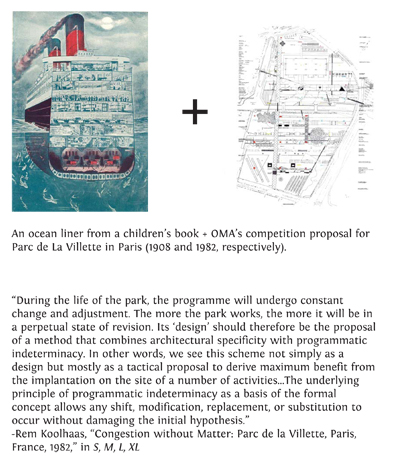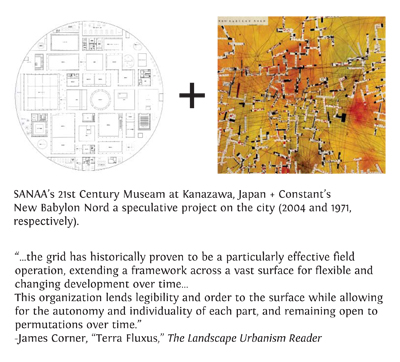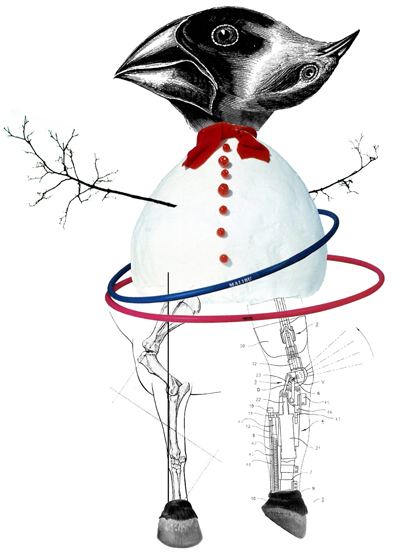
This semester I have been investigating a concept, heterotopia, that I hope will inform my Spring 2011 Degree Project proposal (Degree Project is akin to a graduate thesis project, but has traditionally manifested itself in a somewhat detailed and comprehensive architectural proposal). Below is a short text, some quotes, and a few drawings/collages that attempt to uncover the architectural potentials of the term. Please share your thoughts and responses...
Framework for a Heterotopia
by Aaron Plewke
Heterotopia, literally [an]other place, is a term that was first used in medicine to describe a cell or group of cells living non-malignantly within a host cell or tissue. Michel Foucault adapted the term in the sixties to explain an emerging phenomenon—spaces and places were coming into being which interrupted the apparent continuity and normality of ordinary, everyday space, but did so in a way that was not detrimental to their host. By identifying these places where processes of change and hybridization were being harbored, Foucault implied that heterotopias could be testing grounds for future spatial conditions, and that they could effectively give birth to new norms.
Moving ahead to the present, heterotopias have evolved from being understood as the result of society creating [an]other place within a classical or modernist single-center spatial environment, and are now also theorized as the organizing network or field within which distinct and often contradictory conditions reside (the city as a layered structure of heterotopic nodes and networks, for example).
My current research—initiated in the Fall 2009 studio “[Dis]Located Conditions” taught by Manuel Bailo, Rosa Rull and Adrian Luchini, pursued in my current studio, “A Wonderful World” with Wiel Arets and Robert McCarter, and the subject of my Design Thinking work—operates within this broader contemporary understanding of heterotopia.
Finally, and perhaps most critically, I operate with the belief that heterotopic space can be designed for, or at least instigated.
Heterotopic Transmogrifications
An Ocean Liner and OMA's Parc de La Villette

SANAA's 21st Century Museum and Constant's New Babylon

Genetic Recombination
An Exquisite Corpse, created with James Morgan
Finally, in lieu of a typical program diagram, I created the collage below to demonstrate the heterotopic potential of a specific type of programmatic recombination:
view larger
Thanks for reading!
Aaron
3 Comments
I'm really excited to see what you come up with!! Both in the content of the work itself, but especially the process of doing a self-initiated project in graduate school. We have to petition for the opportunity to do that at Yale and the program is structured so you take studios with assigned projects the whole way through rather than doing a thesis. (Amost no one does - you have to get faculty to sign on to it, and pretty much prove that there is no possible way you could learn/explore your concepts of interest in any of the studios offered that semester) For me, I think that since I don't have an architecture background from undergrad, I am one of those who will actually benefit more from having more studio-like, directed projects so I can focus on the design, concept, and production without also having to invent the program and assignment. I'm just worried there won't be something I love when the time comes!!! You obviously have the background to be able to pull off something like this so I'm looking forward to you & M's work :)
can we move beyond foucault already?
Susan, after watching Degree Project reviews for the past 2 days, I'm tending to think that the setup at Yale makes sense. Of the reviews that I watched, a few of the projects were risky (for lack of a better term) and engaging, and seemed to really allow the student pursuing them to grow...more often they were perfectly safe, refined, elegant, etc., and probably didn't allow the student pursuing them to discover anything they didn't already know. Just another project, though certainly more developed or comprehensive than in typical studios. I guess my point is that another directed studio may serve the majority of students (background in arch or otherwise) better than a self-initiated project. Fortunately, this is an open conversation here, and the format of both Design Thinking and Degree Project are under ongoing adjustment based on dialog between students and faculty. For example, after our recent Design Thinking exhibit/final, we wrapped up by discussing possible tweaks that could be made to the course's format...a kind of course evaluation, but as a group conversation.
kishkash, care to expand on that? I'd be happy to discuss it further...
Block this user
Are you sure you want to block this user and hide all related comments throughout the site?
Archinect
This is your first comment on Archinect. Your comment will be visible once approved.